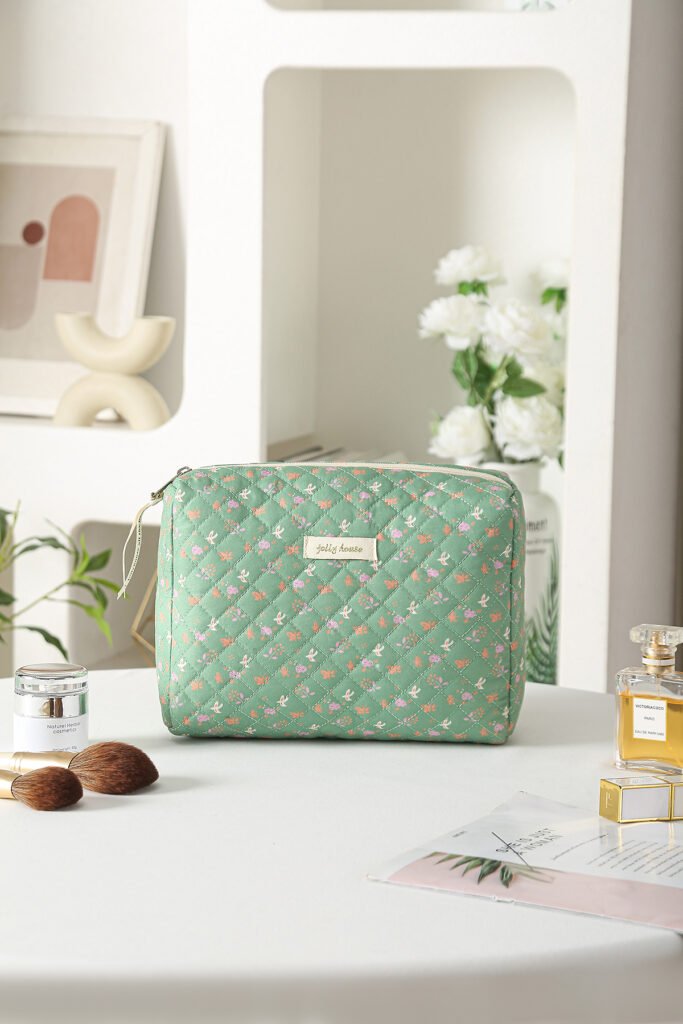The Art and Craft of Sewing PVC Patches onto Cosmetic Bags
In the realm of fashion and accessories, personalization and uniqueness hold a significant allure. Among the myriad ways to customize items, sewing PVC patches onto various surfaces has emerged as a popular and versatile method. This technique, combining functionality with aesthetic appeal, has found its way into numerous applications, with cosmetic bags being a prominent example. In this comprehensive guide, we will delve into the intricacies of sewing PVC patches onto cosmetic bags, exploring materials, techniques, design considerations, and the myriad benefits this customization offers.

I. Introduction
Cosmetic bags, an essential accessory for many, serve not only as a practical storage solution but also as a fashion statement. As individuals seek to express their personality and style through every detail, the customization of these bags has become increasingly popular. PVC (Polyvinyl Chloride) patches, known for their durability, vibrant colors, and versatility, have emerged as a favorite choice for enhancing the visual appeal and functionality of cosmetic bags. This article aims to provide a detailed understanding of the process of sewing PVC patches onto cosmetic bags, from material selection to finished product care.
II. Understanding PVC Patches
A. What are PVC Patches?
PVC patches are decorative or functional elements made from Polyvinyl Chloride, a widely used plastic material. These patches can be produced in various shapes, sizes, and colors, making them highly customizable. PVC patches are known for their durability, water resistance, and ability to retain vibrant colors over time, making them ideal for use on items that may be exposed to moisture or frequent handling, such as cosmetic bags.
B. Types of PVC Patches
- Embroidered PVC Patches: These patches feature intricate designs created through embroidery techniques, often combined with PVC backing for added durability.
- Printed PVC Patches: Designs are directly printed onto the PVC material, allowing for high-detail and color accuracy.
- 3D PVC Patches: These patches incorporate multiple layers of PVC to create a raised, three-dimensional effect.
- Glow-in-the-Dark PVC Patches: Special PVC materials are used to create patches that glow in the dark, adding a unique and eye-catching element.
C. Benefits of Using PVC Patches on Cosmetic Bags
- Durability: PVC patches are highly resistant to wear and tear, ensuring that the customization lasts.
- Water Resistance: Ideal for cosmetic bags that may come into contact with liquids.
- Customization: The ability to create unique designs tailored to individual preferences.
- Versatility: PVC patches can be easily sewn onto various fabrics and materials.
III. Material Selection
A. Choosing the Right Cosmetic Bag Fabric
The choice of fabric for the cosmetic bag will impact how well the PVC patch adheres and how the final product looks and feels. Common fabrics include:
- Cotton: Soft, breathable, and easy to sew, but may require additional reinforcement for heavier patches.
- Polyester: Durable and wrinkle-resistant, with good color retention.
- Nylon: Lightweight and water-resistant, making it an excellent choice for cosmetic bags.
- Canvas: Sturdy and versatile, with a classic look that suits a variety of styles.
B. Selecting the Appropriate PVC Patch
Consider the following factors when choosing a PVC patch:
- Design: Ensure the design complements the overall aesthetic of the cosmetic bag.
- Size: The patch should be proportionate to the bag’s size and placement area.
- Thickness: Thicker patches may require stronger thread and more robust sewing techniques.
- Color: Choose colors that contrast or complement the bag’s fabric for maximum visual impact.
IV. Preparation Before Sewing
A. Gathering Tools and Materials
- Sewing Machine: For efficient and consistent stitching.
- Hand Sewing Needles: For areas that may be difficult to reach with a machine.
- Strong Thread: Polyester or nylon thread is recommended for its durability.
- Pins: To hold the patch in place before sewing.
- Scissors: For cutting thread and fabric.
- Measuring Tools: Rulers and marking pens for accurate placement.
- Iron: To flatten the patch and fabric before sewing (if necessary).
B. Preparing the Cosmetic Bag and PVC Patch
- Clean the Surface: Ensure the area where the patch will be sewn is clean and free of debris.
- Position the Patch: Use pins to hold the patch in the desired location, ensuring it is straight and centered.
- Mark Placement: If necessary, use a marking pen to outline the patch’s position for accurate stitching.
V. Sewing Techniques
A. Basic Sewing Steps
- Thread the Sewing Machine: Choose a thread color that matches or complements the patch and bag.
- Set the Stitch Length: Adjust the stitch length to ensure secure attachment without damaging the fabric.
- Start Sewing: Begin stitching along the edge of the patch, maintaining a consistent speed and pressure.
- Backstitch: At the beginning and end of the stitching, backstitch a few times to reinforce the seam.
- Trim Excess Thread: Once sewing is complete, trim any excess thread for a clean finish.
B. Advanced Sewing Tips
- Edge Stitching: For a more polished look, stitch along the edge of the patch using a zigzag or satin stitch.
- Appliqué Technique: Layer the PVC patch over a piece of fabric before sewing, creating a raised effect.
- Double Stitching: For added durability, stitch around the patch twice.
- Using Adhesive: In some cases, applying a thin layer of adhesive to the back of the patch before sewing can provide extra security.
VI. Design Considerations
A. Patch Placement
The placement of the PVC patch on the cosmetic bag can significantly impact its overall appearance. Consider the following options:
- Front Center: For a bold, statement-making look.
- Corner: For a subtle yet stylish accent.
- Side: To maintain a streamlined look while still adding customization.
- Inside Flap: For a hidden surprise when the bag is opened.
B. Color and Pattern Matching
Choose patch designs that harmonize with the bag’s color scheme and pattern. Contrast can create a striking effect, while complementary colors can provide a cohesive look.
C. Themed Designs
Consider creating themed PVC patches to reflect personal interests, hobbies, or upcoming events. For example, a beach-themed patch for a summer vacation or a floral design for a spring-inspired bag.
VII. Finishing Touches and Care
A. Inspecting the Work
Once sewing is complete, carefully inspect the stitching for any loose threads or missed spots. Make any necessary adjustments to ensure a secure attachment.
B. Cleaning and Maintenance
- Spot Clean: Use a damp cloth to clean the PVC patch and surrounding area. Avoid harsh chemicals or abrasives.
- Store Properly: When not in use, store the cosmetic bag in a cool, dry place to prevent damage to the PVC patch.
- Avoid Excessive Heat: Keep the bag away from direct heat sources, as high temperatures can warp or melt the PVC.
VIII. Conclusion
Sewing PVC patches onto cosmetic bags is a creative and rewarding endeavor that allows individuals to personalize their accessories while enhancing their functionality. By carefully selecting materials, employing proper sewing techniques, and considering design elements, anyone can create a unique and lasting impression with their customized cosmetic bag. Whether you’re a seasoned sewer or a beginner, the process of adding PVC patches to cosmetic bags offers a fun and expressive way to showcase your personality and style.


